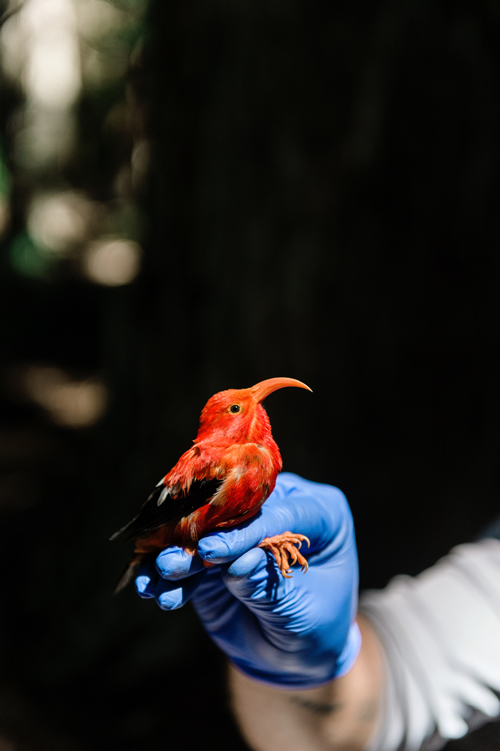As the island’s native birds come dangerously close to extinction, researchers on Kaua‘i have identified a new threat to their survival.
David Kuhn is a quiet man by nature. He rarely raises his gentle, deep-timbred voice higher than a whisper, possibly a result of a lifetime devoted to bird watching. Kuhn grew up in California’s San Joaquin Valley surrounded by a marshland teeming with wildlife. “The deepest part of birding in me started then,” he says.
By the time Kuhn moved to Kaua‘i in 1988, he had been a bird guide for more than two decades. There, he traversed deeper into the wilderness, sharpening his skills to better identify the islands’ unique avian species. He took audio equipment, back then still large and cumbersome, on his expeditions.
In the past 30 years, Kuhn has gathered thousands of hours of bird recordings, some as rare as the call of the elusive ‘i‘iwi, the scarlet honeycreeper once prized by ali‘i (Hawaiian chiefs) and unofficially adopted by Hawai‘i as a symbol of the islands.
Today, Kuhn is known as the Bird Man of Kaua‘i, a living primer on the island’s rarest birds.
“Through years of learning and observing, I can identify most every bird sound …” he says, his sentence trailing off.
He grows silent until all I hear are the soft chirps of birds hidden within the brush of the campground at Kōke‘e State Park, which is nestled along the edge of Waimea Canyon on Kaua‘i.
Kuhn does this often, stopping mid-sentence and cocking his head to one side, analyzing a specific trill. After a beat, he’ll conclude: “That’s a hwamei,” or “Hear that? That’s an ‘apapane.” It’s the bird-watching equivalent of knowing someone on a first-name basis.
Entangling one’s life with these birds, though, comes with a harsh reality.
“When I first arrived on Kaua‘i, one could sit right here and hear most of the native forest birds,” Kuhn says. “That time,” he says somberly, “unfortunately, is long gone since.”
Over the past decade, Kuhn has focused his studies on Hawaiian honeycreepers. In that time, this family of songbirds uniquely adapted to the islands, which includes the ‘i‘iwi and the lemon-plumed ‘akeke‘e, has faced widespread decimation.
Honeycreepers’ songs are more than mere aesthetics; from mating calls to building community, songs are how their societies function.
In 2010, the ‘i‘iwi was listed under the U.S. Endangered Species Act. Recent studies estimate its population at 362,000 birds across the state. In comparison, the ‘akeke‘e, which only exists on Kaua‘i, has fared much worse. Researchers have categorized the species as critically endangered, with a population of less than a thousand.
A rapidly warming climate has increased the habitat for avian-malaria-carrying mosquitos. The insects once only thrived in Hawai‘i’s humid, low-lying forests after arriving in the islands in the 1800s but now can surpass elevations of 1,000 feet.
“There’s really nowhere left for the honeycreepers to go,” Kuhn says, explaining how the birds once found refuge at higher elevations. The remaining sanctuaries are only safe four months out of the year. Scientists have raced to save them from extinction, forming conservation centers to analyze population numbers and establishing catch-and-breed programs.
Then, 10 years ago while out in the field, Kuhn noticed a honeycreeper, an ‘akeke‘e, singing the songs of another species. “I thought I was losing my field skills!” Kuhn says, chuckling softly. “But that was my first graphic inkling that this, what was happening with the honeycreepers, was different.”
Honeycreepers’ songs are more than mere aesthetics; from mating calls to building community, songs are how their societies function. Because of their decimated populations and the absence of matured birds to learn from, fledglings have begun to mimic songs of other honeycreepers. With a breakdown in their songs, Kuhn says, comes a breakdown in their societies.
“It shows how dysfunctional the birds are becoming,” says Kristina Paxton, a post-doctoral researcher at the University of Hawai‘i at Hilo who conducted a study based on Kuhn’s observations. She gathered audio recordings of three Kaua‘i honeycreepers chosen for availability of auditory data: ‘akeke‘e, ‘anianiau, and the Kaua‘i ‘amakihi.
Through an analysis of four decades of bird recordings made by Kuhn and other recordists, Paxton and her co-authors confirmed Kuhn’s fears—and worse. The work revealed that not only were the birds trading songs, but compared to just two decades prior, the melodies have simplified.
Whereas their ancestors sang complex and symphonic tunes, the honeycreepers studied had lost the unique melodic characteristics that their species had developed over millions of years. Though the study, published in August 2019 in the journal Royal Society Open Science, encompassed just three honeycreepers, Paxton says it could be part of a larger trend and plans to extend her research.
“This project, it’s not a happy one,” Kuhn says. He pauses to take a stabilizing breath. When he looks up, his eyes glisten with unshed tears. “I’ve known these birds for decades and to hear them disappear—just like that.”
Loss of song diversity, Paxton says, points to the larger issue of the species’ viability.
“It’s possible that one day, a perfectly viable ‘akeke‘e will be right next to another but they won’t recognize each other,” she says. “If they can’t recognize each other, then they can’t mate.”
But there is still hope. At the capture-and-breed programs of Hawai‘i Island’s Keauhou Bird Conservation Center and the San Diego Zoo, conservationists are playing recordings that Kuhn has made throughout his career of honeycreepers in the wild in hopes that the birds in captivity will pick up on the nuances of their songs.
“It makes me happy,” Kuhn says, “to think that the sounds I’ve left behind when I’m gone will be valuable.” The recordings have the potential to help these birds learn a complex repertoire, like the ones of their ancestors.
READ ALSO: Foraged Flora
Atop Tantalus, a Honolulu couple bring people closer to nature by sharing flowers grown in their backyard.




